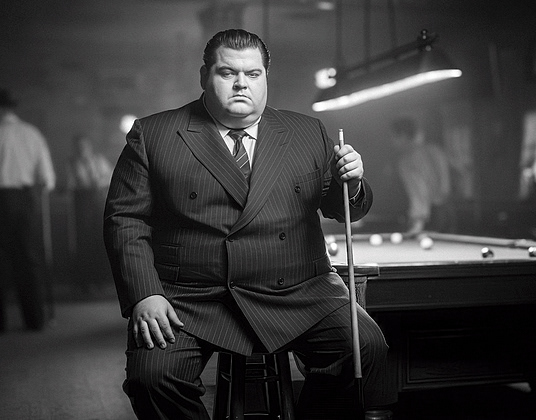Bob Orsillo's black and white photograph, "Shadows of the Game," is a masterful depiction of a moment frozen in time within the confines of a dimly lit pool hall. This image, rich in detail and atmosphere, invites viewers to step into a world that feels both nostalgic and timeless.
At the heart of the photograph is a central figure, a person whose identity is shrouded in mystery. This individual, clad in a denim jacket and a hat, sits casually on the edge of a pool table, holding a pool cue with a relaxed yet purposeful grip. The choice to obscure the person's face adds an element of intrigue, allowing viewers to project their own narratives onto the scene. The hat and denim jacket, staples of mid-20th century fashion, further enhance the vintage feel of the photograph.
The lighting in "Shadows of the Game" is a critical element that Orsillo uses to great effect. A strong overhead light casts a dramatic glow on the central figure, creating stark contrasts between light and shadow. This chiaroscuro technique not only highlights the textures of the denim and the smooth surface of the pool table but also adds depth and dimension to the scene. The shadows cast by the light create a moody, almost noir-like atmosphere, reminiscent of classic black and white films.
In the background, two other individuals are engaged in a game of pool. Their presence adds a sense of activity and life to the scene, suggesting that this is a place where stories unfold, and interactions occur. One of these background figures is also wearing a hat, creating a visual link to the central figure and reinforcing the photograph's cohesive aesthetic. The focus on these background players is softer, drawing the viewer's attention primarily to the central figure while still providing context and depth to the setting.
The pool hall itself, with its vintage decor and dim lighting, serves as more than just a backdrop; it is an integral part of the photograph's narrative. The setting evokes a sense of nostalgia, transporting viewers to a bygone era where such establishments were social hubs. The use of black and white film enhances this nostalgic quality, stripping away the distractions of color and allowing the viewer to focus on the interplay of light, shadow, and texture.
Orsillo's composition is meticulously crafted, with each element carefully placed to guide the viewer's eye through the scene. The lines of the pool table and the cues create a sense of movement and direction, leading the viewer from the central figure to the background players and back again. This dynamic composition ensures that the viewer's gaze is constantly engaged, discovering new details with each look.
In "Shadows of the Game," Bob Orsillo has created a photograph that is both a visual and emotional experience. The image captures a moment that feels both fleeting and eternal, inviting viewers to step into a world of mystery, nostalgia, and timeless beauty. Through his expert use of lighting, composition, and subject matter, Orsillo has crafted a piece that resonates on multiple levels, making it a standout work in his portfolio.





